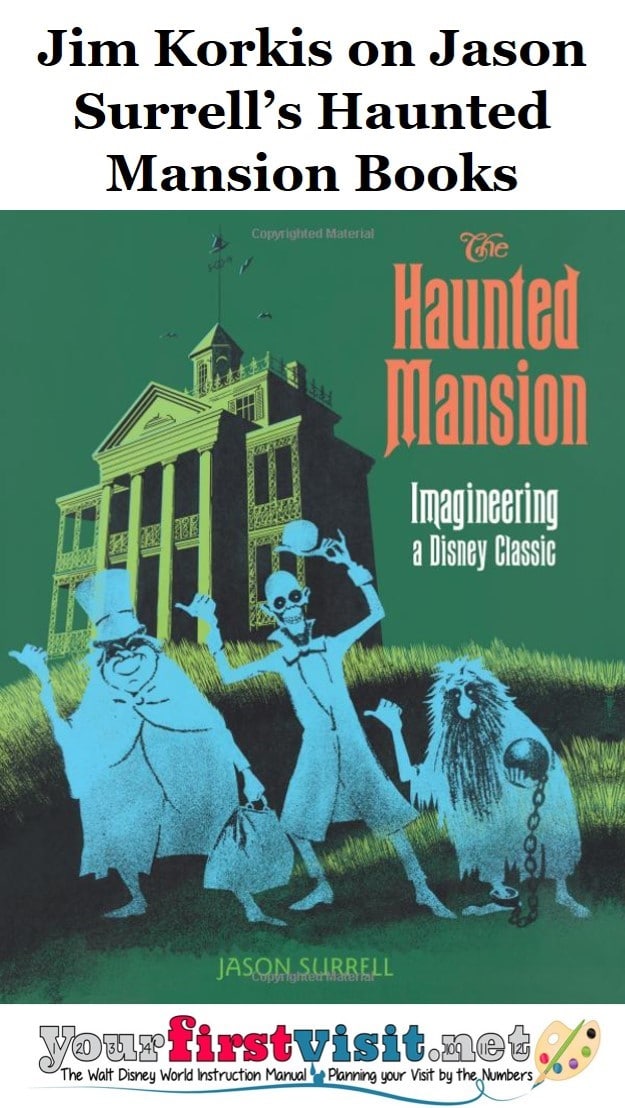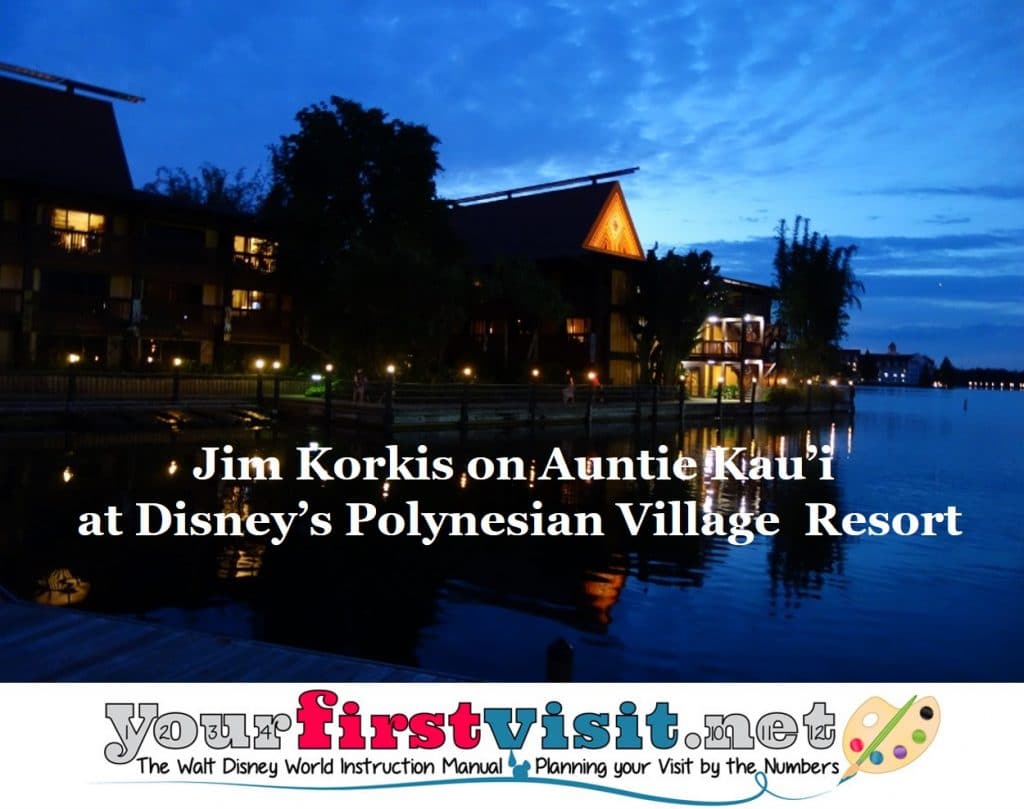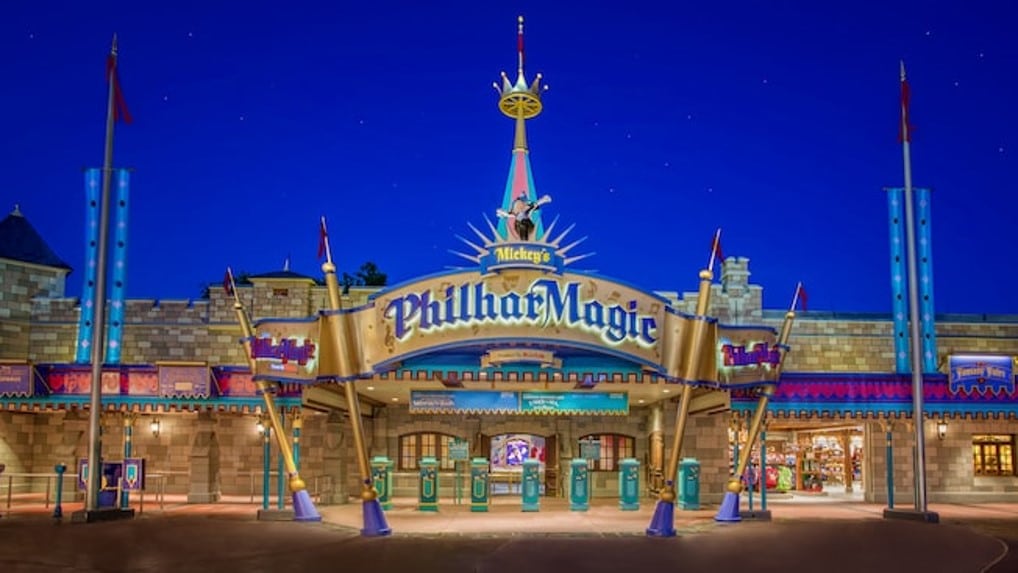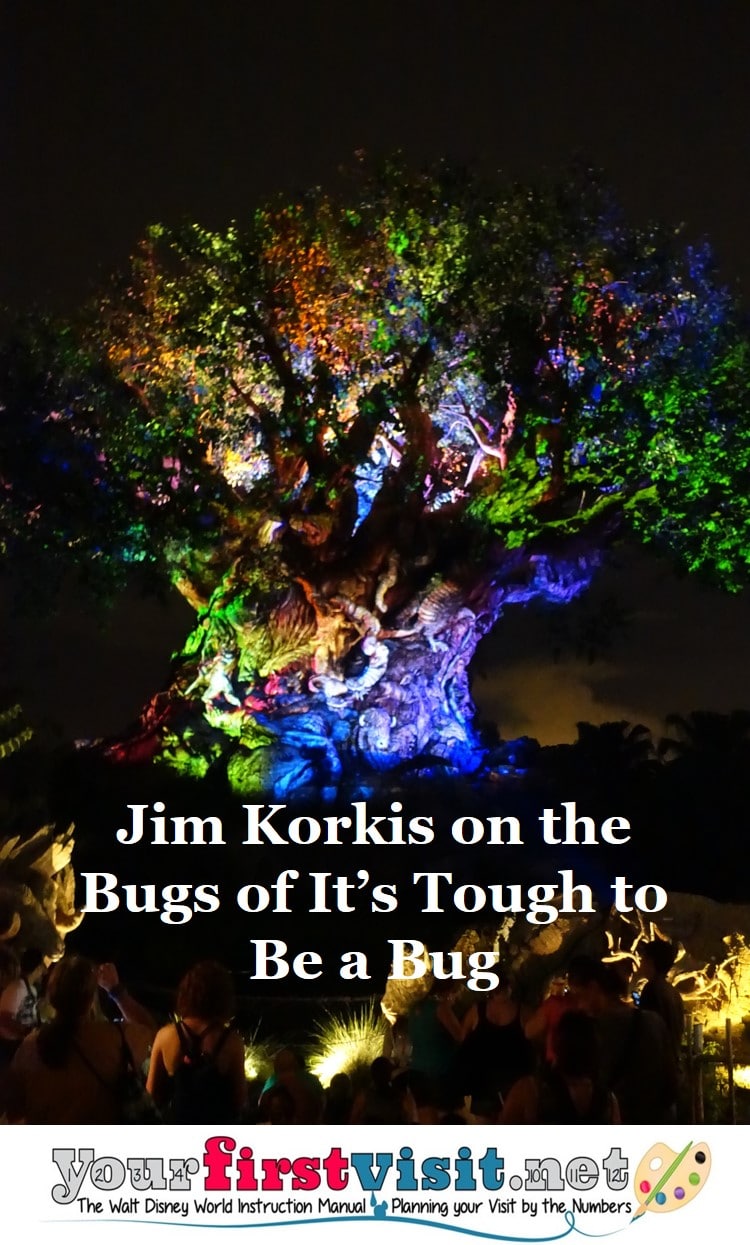Category — A Friday Visit with Jim Korkis
A Friday Visit with Jim Korkis: Mickey’s PhilharMagic
Welcome back to Fridays with Jim Korkis! Jim, the dean of Disney historians, writes about Walt Disney World history every Friday on yourfirstvisit.net.
MICKEY’S PHILHARMAGIC
By Jim Korkis
At the Magic Kingdom, the show building that currently houses Mickey’s PhilharMagic Concert Hall beginning in 2003 once housed the Magic Kingdom opening day attraction, Mickey Mouse Revue. Both attractions feature Mickey as a conductor leading an orchestra in some of the classic tunes from the Disney songbook.
Mickey Mouse Revue was removed from the Magic Kingdom in 1980 and transplanted to Tokyo Disneyland where it lasted from 1983 until 2009 when it was replaced by Mickey’s Philharmagic.
Mickey’s Philharmagic is a twelve minute film written by Alex Mann and directed by George Scribner, who directed the animated feature Oliver and Company (1988). It recounts the misadventures after Donald Duck borrows Mickey Mouse’s magical hat from the Sorcerer’s Apprentice. Donald is swept away into several different Disney animated features scenarios as he tries to catch the errant hat.
Although the starting point is that Mickey Mouse will be conducting the PhilharMagic Orchestra at the Fantasyland Concert Hall, just as he had lead several orchestras in his short cartoons, Mickey appears just briefly at the beginning and the end of the show. A total of fourteen different Disney animated characters appear.
At 150 feet wide by 28 feet tall, the screen for Mickey’s PhilharMagic is the largest seamless projection screen in the world. The theater accommodates up to 496 guests (including those in wheelchairs/ECVs) who use 3-D “opera glasses” to enjoy the show.
Wayne Allwine originally supplied the voice for Mickey Mouse when the attraction opened. Most of Donald Duck’s lines were pieced together from sound tracks of old cartoons where he was voiced by his original voice Clarence Nash. Tony Anselmo, the current voice of Donald, supplied only five new lines such as the scene where Donald Duck hums to the tune of the song Be Our Guest .
It is considered a 4-D attraction, meaning that in addition to the 3-D film itself, there are other elements like scents (including apple pie offered by Lumiere), water spray (in Ariel’s underwater world), the jets of air (while flying over London) and a figural rear end of Donald Duck struggling in the back wall of the theater at the end of the show. The rest of Donald can be found in the wall of the Fantasy Faire merchandise shop after exiting the attraction.
It is one of the very few attractions where WDI collaborated directed with Walt Disney Animation Studios, as it did with Fantasmic!
The entire production of Mickey’s PhilharMagic was created totally on computer, representing the first time the featured classic Disney characters were completely modeled and animated by computer. The next time was in the straight-to-video Twice Upon a Christmas released a year later in 2004.
Animator Nik Ranieri, who brought Lumiére to life for the original animated feature Beauty and the Beast, returned to render him in 3-D for Mickey’s PhilharMagic. This was the final time that actor Jerry Orbach reprised his role as Lumiere before his death in 2004.
Animator Glen Keane, who animated Ariel in The Little Mermaid, also returned to animate her for this film. It was his first time doing computer animation.
Songs featured in the show include Be Our Guest, I Just Can’t Wait to Be King, Part of Your World, A Whole New World, You Can Fly!, and instrumental versions of Sorcerer’s Apprentice and the Mickey Mouse Club March.
Mickey’s PhilharMagic was the seventh 3-D film presented at WDW following previous films including Captain EO, Honey, I Shrunk the Audience, Magic Journeys, Muppetvision 3D, It’s Tough to be a Bug and Working for Peanuts.
“We’re always exploring ways to take 3-D to the next level,” said Tom Fitzgerald, executive vice president and senior creative executive at Walt Disney Imagineering in January 2002. “We keep looking for new ways to allow guests to become a part of the action and story. Mickey’s PhilharMagic will be the most animated, energetic and magical 3-D show we’ve ever created!”
* * * * *
Thanks, Jim! And come back next Friday for more from Jim Korkis!
In the meantime, check out his books, including his latest, More Secret Stories of Disneyland, and his Secret Stories of Walt Disney World: Things You Never You Never Knew, which reprints much material first written for this site, all published by Theme Park Press.
Follow yourfirstvisit.net on Facebook or Twitter or Pinterest!!
August 10, 2018 No Comments
A Friday Visit with Jim Korkis: The Disney World Gateways
Welcome back to Fridays with Jim Korkis! Jim, the dean of Disney historians, writes about Walt Disney World history every Friday on yourfirstvisit.net.
THE DISNEY WORLD GATEWAYS
By Jim Korkis
For those of us who live in the Walt Disney World area, roads and traffic have been a major mess for the last few years, especially around the Magic Kingdom where the roadways are constantly shifting and familiar routes no longer exist. [A new flyover is expected to open in a couple of weeks—Dave.] Disney’s Hollywood Studios will soon have a new entrance as well, once construction has been completed on roadways being built in anticipation of the new Star Wars: Galaxy’s Edge land in Disney’s Hollywood Studios.
Even Disney Springs has become so crowded that a third new parking garage is almost completed, and additional roadwork on Buena Vista Drvie continues seemingly on a never-ending schedule.
However, an important entrance icon that we usually take for granted still exists as a landmark to announce that we have arrived on WDW property.
The original concept for Walt Disney World was that guests would unexpectedly discover the vacation destination, so there was only minimal signage along the roads.
By the time Michael Ovitz was hired as president in 1995 to take the role previously held by Frank Wells, attendance at the parks had grown so large that this intriguing conceit was no longer effective. When Ovitz and his wife visited the Walt Disney World property, Judy Ovitz complained that she couldn’t tell where Disney property truly began.
Michael Ovitz approached CEO Michael Eisner with the complaint and, as a gesture to show his willingness to work with the new president, authorized the building of three gateways on the perimeter of Walt Disney World property.
Groundbreaking ceremonies were in April 1996 for three colorful gateways that would define when guests had arrived on WDW property. One gateway was planned for World Drive, another for Epcot Drive and the final one at the far northeast end of Hotel Plaza Boulevard.
Ovitz had suggested that they be decorated by huge iconic smiling figures of Mickey and Minnie because the primary audience was families with children.
The gateways were officially completed in September of that year and were similar but with slight variations in size. Each gateway was thirty feet high, with sixteen foot high characters and a purposely bright color palette of red, yellow, purple and green, to match already existing property signage.
Now retired Disney artist Don “Ducky” Williams told me: “Yes, that is my artwork of Mickey and Minnie but I didn’t do it specifically for those entranceways. I did a lot of work of the Disney characters in poses that could be used on material and it was in the Disney Design Group files. Imagineering just took it which they often did and never told me and used it. That was not a problem. It was just part of my job to do things like that.”
The images of Donald and Goofy were done by Disney Design Group artist Darren Hunt.
Arches with colorful flags adorned the World Drive and Epcot Drive entrances but there was no arch on the one at Hotel Plaza Boulevard, so there were no height restrictions for delivery trucks.
According to Hal McIntyre, vice president of WDI Planning and Infrastructure in 1996, the goal of the collaboration between Imagineering (that designed the gateways) and Walt Disney World was to “create a first class, high quality image that marks the resort’s boundaries. The gateways’ message is simple: You have arrived at Walt Disney World!”
McIntyre pointed out that the idea of a prominent gateway to the property had continually been brought up over the years beginning as far back as 1988. At that time, gateways had been designed and were ready to move forward when for undisclosed reasons they were shelved at the next to last minute sometime in 1990.
Senior show designer Michale Warzocha emphasized that the gateways were meant to represent WDI’s “tribute to the WDW Resort front door.” He acknowledged the contribution and support of Ovitz to finally getting these gateways done.
It turned out to be one of the few contributions by Ovitz to Walt Disney World. Ovitz was let go in January 1997 after being very vocal about being frustrated with his interactions with Eisner and the vague definition of his authority.
A challenge quickly arose where the gateways were so distinctive and attractive that guests were stopping their cars in order to take their pictures next to the entryway.
However, Imagineers had not created a space for this to happen, so it became a major safety issue. Instead of designing an area where this could be done, WDW put up warning signs, barriers and occasionally parked police cars to discourage this practice.
* * * * *
Thanks, Jim! And come back next Friday for more from Jim Korkis!
In the meantime, check out his books, including his latest, More Secret Stories of Disneyland, and his Secret Stories of Walt Disney World: Things You Never You Never Knew, which reprints much material first written for this site, all published by Theme Park Press.
Follow yourfirstvisit.net on Facebook or Twitter or Pinterest!!
August 3, 2018 2 Comments
A Friday Visit with Jim Korkis: The Haunted Mansion
Welcome back to Fridays with Jim Korkis! Jim, the dean of Disney historians, writes about Walt Disney World history every Friday on yourfirstvisit.net.
YOUR PERSONAL DISNEY LIBRARY (8)
By Jim Korkis
- The Haunted Mansion: From the Magic Kingdom to the Movies (2003) and
- The Haunted Mansion: Imagineering a Disney Classic (2015)
both by Jason Surrell.
The Disney theme parks around the world have attractions that share the same name but have significant differences. Not only are the it’s a small world facades and ride systems completely different at Disneyland and Walt Disney World but they also have subtle little other different touches as well.
For instance, the attraction at Disneyland has a figure honoring Imagineer Mary Blair, the original designer. At Walt Disney World, that figure is replaced with one for Imagineer Joyce Carlson, who supervised the installation of the one in Florida and at the other Disney theme parks.
The Haunted Mansion appears at every Disney theme park worldwide, but in different lands, and that affects not only the exterior show building but also how it relates to its surrounding area. Jason Surrell’s books provide a good deal of information not just about the WDW version but also a similar overview of the other incarnations around the world.

One of the challenges in building a personal Disney library is that a book may be revised and updated and released with a slightly different title. In the process, it is not just new information that is added but older information may be omitted as well.
For instance, the 2003 book version devotes almost a third of its text to the underwhelming 2003 Eddie Murphy film based on the attraction, in order to promote the film. Those pages of material are completely missing from the 2015 version and in its place is information on Hong Kong Disneyland’s Mystic Manor and new additions completed at both the Disneyland and Walt Disney World attractions.
However, the second book does include much of the same text and illustrations as the first one. I always make sure both versions are in my library but if you can only purchase one, then the most recent edition is usually the recommended choice.
Both books are written by Imagineer Jason Surrell, who was a long time show writer for the Disney Company until he left just a couple of years ago to become a creative director at Universal Creative. Among his many credits were enhancements to the Haunted Mansion and Pirates of the Caribbean attractions at both Disneyland and Walt Disney World.
As a Disney writer, Surrell’s text is lively and informative, although there are occasional hints that he may have been constrained in some places in telling the whole story because this is an approved Disney narrative.
Not only his direct involvement in the Haunted Mansion, but also his access to proprietary Imagineering material about the history and development of the attraction, brings new stories and illustrations, and also a new perspective to things we all thought we already knew.
Which character other than Madame Leota is referred to by a specific name in the original Imagineering documentation? It is Pickwick, the ghost swinging atop the chandelier in the ballroom and holding a glass. Why is he named Pickwick? The answer is in the book.
For me, one of the delights of the book is the second half where it goes through the attraction section-by-section (with sidebars of differences at the other parks) as a virtual journey through the experience.
Surrell went on to write books about the Pirates of the Caribbean attraction and the Disney mountains and I am sure he had many, many more stories to share.
If you are particularly interested in the original Disneyland version of the Haunted Mansion, I highly recommend The Unauthorized Story of Walt Disney’s Haunted Mansion (Second Edition 2016) by Jeff Baham, an acknowledged expert on the attraction who includes some facts and insights not in the Surrell books.
* * * * *
Thanks, Jim! And come back next Friday for more from Jim Korkis!
In the meantime, check out his books, including his latest, More Secret Stories of Disneyland, and his Secret Stories of Walt Disney World: Things You Never You Never Knew, which reprints much material first written for this site, all published by Theme Park Press.
Follow yourfirstvisit.net on Facebook or Twitter or Pinterest!!
July 27, 2018 No Comments
A Friday Visit with Jim Korkis: Auntie Kau’i at the Polynesian
Welcome back to Fridays with Jim Korkis! Jim, the dean of Disney historians, writes about Walt Disney World history every Friday on yourfirstvisit.net.
AUNTIE KAU’I AT DISNEY’S POLYNESIAN VILLAGE RESORT
By Jim Korkis
Three months ago, I spent over an hour sitting in the lobby of the Polynesian Village Resort. I wasn’t waiting for anything or anyone. I was sitting next to a genuine WDW treasure: Auntie Kau’i Brandt.
As she does many days, she was sitting at a table as guests rushed by, not paying any attention. She was slowly and carefully making a lei as she has done for many years. And she was very generously talking to me with a big smile on her face.

“We saw the planes flying overhead. My mom told me, ‘It’s war. Get off the roof.’ I said, ‘What’s war?’ We didn’t know what war was. But, we learned. It was a tough time.”
Brandt grew up during a time when speaking Hawaiian was forbidden and kahiko-style (traditional) hula was taught only in secret. At the time, hula was considered vulgar because of the swaying hips and so was often used for comedic purposes with performers in cellophane skirts.
In 1971, Kau’i Brandt, better known as “Aunti Kau’i”, moved from Pearl City, Hawaii on the island of Oahu to California for eight months to perform in the Polynesian show at Disneyland’s Tahitian Terrace. She had previously been approached three different times in the 1960s by Disney representatives to relocate to Southern California but each time she refused, fearing that once she left she might never come back.
Shortly after coming to Disneyland, she moved to Florida with her husband Pono to open the Kau’i-Pono Polynesian Revue at the new Disney Polynesian Village Resort.
She was the master of ceremonies for the show and remained as a cultural representative at the resort for decades. Among other things as a cultural representative, she would sit in the lobby as she does today and create the authentic leis from real flowers to give to couples celebrating honeymoons or anniversaries as well as stopping occasionally to give children Hawaiian cookies and to give hula lessons.
She was born during a Hawaiian thunder and lightning storm in 1932 and was named “Kauihealani” which means “thundering voice of heaven”. She uses the shortened version “Kau’i”.
“I studied the dances of Samoa, Tahiti, Tonga, Hawaii and the Maori dances of New Zealand,” said Kau’i. “My teachers were always from the islands where the dances are still performed and knew the legends and traditions told in each dance. I taught and I learned. Many of my teachers were from the Mormon Church College on the island of Oahu in Hawaii.
“When Pono and I learned that the Disney organization was looking for a company of Polynesian artists to perform at Walt Disney World in 1971, we decided to put together a show that would be both authentic and exciting.”
In 1972, the Kau’i – Pono company had twenty-eight young dancers and musicians and more than one hundred dances in their repertory. At that time, the company appeared three times nightly in the Papeete Bay Verandah restaurant and at the evening luaus on the beach.
“Guests ask us if we miss our islands, if we ever get homesick for our flowers, waterfalls, mountains and rolling waves,” smiled Brandt. “I tell them that we bring the islands with us in our songs, in our dances and especially in our spirit of aloha – the gift of the islands to all who enjoy life.”
* * * * *
Thanks, Jim! There’s more on the Polynesian beginning here, and for more about Auntie Kau’i and other Poly cast members see Steve Seifert’s Tikimanpages.com here.
And come back next Friday for more from Jim Korkis!
In the meantime, check out his books, including his latest, More Secret Stories of Disneyland, and his Secret Stories of Walt Disney World: Things You Never You Never Knew, which reprints much material first written for this site, all published by Theme Park Press.
Follow yourfirstvisit.net on Facebook or Twitter or Pinterest!!
July 20, 2018 No Comments
A Friday Visit with Jim Korkis: The Bugs of It’s Tough to be a Bug
Welcome back to Fridays with Jim Korkis! Jim, the dean of Disney historians, writes about Walt Disney World history every Friday on yourfirstvisit.net.
THE BUGS OF IT’S TOUGH TO BE A BUG AT DISNEY’S ANIMAL KINGDOM
By Jim Korkis
Bugs make up nearly ninety percent of what it referred to as the “animal kingdom” so it seemed natural to include them in some way in Disney’s Animal Kingdom. After many other suggestions, it was decided to do a show inside The Tree of Life.
Then-CEO Michael Eisner himself told the Imagineers to check out the newest Pixar animated feature film that was currently in production, A Bug’s Life, that was scheduled to be released in November 1998.
The animated film was released after the attraction It’s Tough to be a Bug, “a creepy, crawly bug-eyed adventure” opened a full seven months earlier. This made It’s Tough to be a Bug one of the handful of Disney theme park attractions based on a film to open before the film it is based on. The very first was Sleeping Beauty Castle at Disneyland. It opened in 1955 but the film it references was not released until 1959.
The final concept of It’s Tough to be a Bug was that guests would wander through the roots of the tree into a theater space that had been hollowed-out by the bugs and seats approximately 430 guests. Guests then don “bug-eye” spectacles in order to see in three-dimensions the world through the eyes (or multiple eyes) of their insect hosts.
Senior principal production designer Zsolt Hormay, who led an international team of sculptors to carve the animals on the exterior trunk of The Tree of Life, was also in charge of the bugs in the queue line for the attraction. “I get calls all the time,” said Zsolt, “Any leeches? No leeches! Any cockroaches? No cockroaches!”
The Imagineers used Flik the ant and Hopper the grasshopper from the film as key figures in the attraction, but also added a Acorn Weevil (The Termite-ator), Chili, a quill throwing Chilean tarantula, Rolly, the dung beetle and the stinkbug Claire de Room to accompany a cast of hundreds of butterflies, beetles, ladybugs, hornets, spiders and larvae.
Some of the bugs appear on film. Some appear as elaborate audio-animatronics characters. Some only exist as puffs of air and rollers built into the theater seats. The bug-swatter effect is created by fifty high-speed fans hidden thirty feet overhead in the rockwork folds of the theater.
When the acid-spraying termite apparently squirts guests in their face, the harmless water spray comes from the seat in front of you. Imagineers chose an industrial smell officially labeled “earthy” for the stinkbug’s distinctive effect.
“It was a matter of getting our special effects to match the bugs,” said show writer Kevin Rafferty. “All the acts we feature in the show are based on what they do in nature. There really are acid-spraying termites and quill-throwing tarantulas.”
At the time, Hopper was the most sophisticated and advanced audio-animatronics characters that Imagineering ever created, and can perform a wide array of movements that make him as lifelike as possible.
Actor Dave Foley recreates the voice of Flik as he did in the original film. The voice of Hopper is not Kevin Spacey as it was in the film, but rather Andrew Stanton, who was co-director of the original film.
Cheech Marin does the voice of Chili. French Stewart the voice of the “Termite-ator”, Tom Kenny the voices of the Dung Beetle Brothers and Jason Alexander as the voice of Weevil Kneevil. Corey Burton is the announcer and the voice of various bugs.
P.T. Flea, voiced by John Ratzenberger as he was in the actual film, pops in briefly for one line, because Ratzenberger is considered “Pixar’s Good Luck Charm,” having voiced a character in every Pixar film. He is the voice of the villain Underminer in the new Incredibles 2.
* * * * *
Thanks, Jim! And come back next Friday for more from Jim Korkis!
In the meantime, check out his books, including his latest, More Secret Stories of Disneyland, and his Secret Stories of Walt Disney World: Things You Never You Never Knew, which reprints much material first written for this site, all published by Theme Park Press.
Follow yourfirstvisit.net on Facebook or Twitter or Pinterest!!
July 13, 2018 No Comments
A Friday Visit with Jim Korkis: Copper Creek Villas and Cabins
Welcome back to Fridays with Jim Korkis! Jim, the dean of Disney historians, writes about Walt Disney World history every Friday on yourfirstvisit.net.
THE COPPER CREEK VILLAS AND CABINS AT DISNEY’S WILDERNESS LODGE
By Jim Korkis
The Copper Creek Villas and Cabins at Disney’s Wilderness Lodge opened in July 2017 as the fourteenth Disney Vacation Club resort
Imagineer project manager Mitch Mioelli stated, “We were pulling from different materials and objects that were indigenous to the Pacific Northwest.
“What we wanted to do, knowing that this resort would have been here for hundreds of years, is take materials that these settlers would have found on site and the rejuvenation and sort of re-gentrification of the area. It’s found objects that would have almost been artifacts from the mining area from the railroad. They would have been repurposed and built into their everyday houses and everyday construction.”
“Everything was coming westward on the trains and this is really an homage to Walt (Disney) and his love of trains and the westward expansion of the United States. So we played on that to make everyone feel that this was an early settlement. Everything is rooted in the history of railroad and the natural environment. We wanted to make it feel like the interior expanded into the exterior, so there’s floor-to-ceiling windows.”
Ken Potrock, Senior Vice President and General Manager of the Disney Vacation Club said that “our guests have told us they don’t want any old hotel; they want themed hotels. They want a hotel that has a back story. They want to hear “is there a connection to Walt Disney?’ So we worked hard to give them what they wanted.”
Where the tale of the original structures at Wilderness Lodge draw their story from the 1800s, the new Copper Creek Villas & Cabins are tied to a slightly later period, when the railroad, mining, and quarry managers and foremen brought their families out west and built homes (like the cabins) along the lakes with some of the materials and objects found in the area.
The story is that the units employ “up-cycling” of materials like rustic tracks and reclaimed wood, as well as giant cogs that form a wall hanging and an occasional Hidden Mickey. Light fixtures are made from shards of colored glass from the quarry and, above the dining table, a chandelier features a giant cog from a crane.
Artwork in the rooms plus exposed steel beams and lots of wood are all used to reinforce the story. However, there are also playful references to Ruke and Tuke from Brother Bear (2003) and Chip ‘n’ Dale. The villas and cabins also have imitation wood flooring that according to Miorelli was “hand-scraped to make it feel like it came out of a sawmill.”
The former Hidden Springs pool was replaced with a significantly larger pool named the Boulder Ridge Cove pool, with a zero-entry feature, more deck space, and a lot of decorative rockwork all around that is reminiscent of the sort of natural stone quarry that may be found in the Pacific Northwest. Nearby is a crane recycled from Disney Hollywood Studios now closed Catastrophe Canyon.
The Imagineers attempted to maintain a linear time lime for the entire set of buildings, from the arrival of the Transcontinental Railroad in the Pacific Northwest spurring the development of rustic residential communities (Boulder Ridge Villas) to grand vacation lodges that attracted visitors coming to the U.S. National Parks (Disney’s Wilderness Lodge).
This was followed decades later by the abandonment of the railroad (in favor of cars, planes, etc.), at which time resourceful locals turned railroad relics (abandoned quarries, mines, train stations, railroad-supervisor residences, etc.) into new living spaces for today’s travelers (Copper Creek Villas & Cabins).
* * * * *
Thanks, Jim! There’s reviews of all three parts of the Wilderness Lodge complex on this site:
And come back next Friday for more from Jim Korkis!
In the meantime, check out his books, including his latest, More Secret Stories of Disneyland, and his Secret Stories of Walt Disney World: Things You Never You Never Knew, which reprints much material first written for this site, all published by Theme Park Press.
Follow yourfirstvisit.net on Facebook or Twitter or Pinterest!!
July 6, 2018 No Comments






